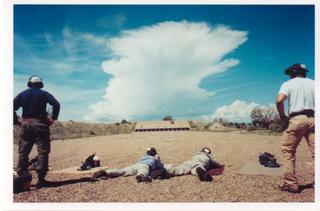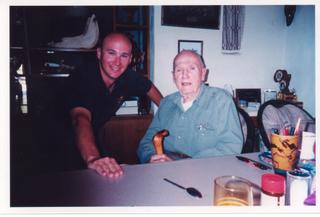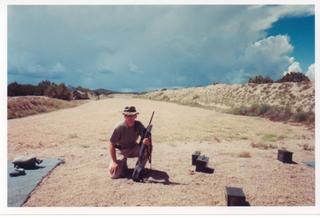Gunsite General Rifle Course

In the 23 April 2003 edition of National Review Online, while reviewing a terrorism survival guide, columnist James Swan suggested that those interested in learning how to keep and bear arms as an aid to homeland defense would do well to seek formal instruction in this honorable art. He recommended Gunsite Academy as one place that the average citizen could go for just such a course. I didn’t exactly follow his advice, as I had already signed up for a course at Gunsite, but I can strongly second his endorsement. Gunsite is a citizenship academy, taught through the medium of firearms.
My Gunsite class in August, 2003 numbered ten students—two shy of a full complement. After registration we milled about smartly in the classroom, looking at the plaques and thank-yous from police agencies and armed forces around the world, making introductions and small talk. First names mostly and not much else, but with no guardedness; simply put, none of us had ever met before.
If we met as strangers, we would part in five days’ time as friends and equals. The class we had gathered for was the General Rifle Course, the “270,” at Gunsite Academy in northern Arizona. We came to learn, not to be taught, the art of practical rifle marksmanship. To be taught is far too passive a thing for any shooting school and especially this school; one goes to Gunsite to learn.
Gunsite Academy, located about 30 minutes’ drive north of Prescott, Arizona, is the prototypical modern shooting school; others (good ones, it should be said) exist around the country, but Gunsite was really the first and it remains the foremost. It was founded in 1977 by a redoubtable retired Marine, LtCol Jeff Cooper, who is one of the founders and main proponents of the modern technique of practical shooting. Its stated mission is, “to provide good people with the skills by which they may conduct themselves as responsible citizens of a free Republic.” There is no political element to the course, but it necessarily appeals to the more traditional ideals of American citizenship.

The author with Gunsite's founder, LtCol Jeff Cooper, USMC (ret.). Though he no longer teaches, he remains a dominating figure, living on the property in a magnificent house of his own design. He and his wife are rightly famous for their hospitality; I for one will remain forever grateful.
As we got to know each other better over the next few days, it did emerge that there were more citizens than soldiers. This was a pleasant and refreshing note: one would expect military and police to be interested in superior practical shooting, less so their civilian brethren. There were two doctors; a middle-aged couple; a lanky young man who had been a hunting guide (and turned out to be a phenomenal rifleman); two businessmen; a Gunsite employee who had not yet taken the rifle course; a Marine reservist just back from Iraq; and I, another Marine reservist. The youngest was 25, the oldest 50 or so. Just two of us had substantial military backgrounds, and none had police experience. Four had been to Gunsite more than once before. All were hunters or serious shooters.
The course stepped off quickly: after a couple hours in the classroom going over the philosophy and elements of practical rifle shooting, marksmanship fundamentals, the omnipresent and unbreakable safety rules (and the consequences of violating them), we headed to the ranges and there we stayed for the rest of the week. A couple days ended in brief classroom work, but the bulk of the instruction was on the range. We shot all day, every day, and even once at night. By the end of the week each of us would put over 500 rounds through his or her rifle, at moving and stationary targets, and at known and unknown ranges, with ever-increasing speed, accuracy and confidence.
We shot on a variety of ranges, from the familiar known-distance “square” range with a target line and a firing line, to terrain walks simulating bush conditions with targets at unknown distances, to a very challenging shoot-and-move course called the Scrambler. We shot on paper targets, but ones without nice round black bull’s-eyes; the Gunsite targets force you to choose an aiming point. We also shot on steel silhouettes. There is no target shooting more satisfying that nailing a steel target. Bam! KLANGG! Instant feedback. We all found that we tended to shoot better in every way when we were shooting on steel.
The Marine Corps has given me a good base in marksmanship; that I didn’t always display the skill I should have displayed brings me to my next point. If you think you can shoot, a Gunsite course will show you in great detail what you don’t know about shooting. Even experienced riflemen will benefit from the 270, from being drilled continually in the basics, under the watchful eyes of premier instructors. Here’s one example: we were shooting at 300 meters, prone, and I was having the worst time of it. My shots were all over the place, and I was not enjoying myself. From behind me came an older gentleman we hadn’t seen on the range before, wearing the Gunsite instructor’s shirt and cap. In very short order he had me back on target and putting the rounds exactly where I wanted them. He did this by watching me, not the target; the solution was in application of the fundamentals. (And to add embarrassment to frustration, this gent turned out to be a retired Marine Major, not only a WWII vet but a Raider as well. He stayed all that day and the next, and was a great teacher as well as a fascinating man.)
The author on the 300m range-- scene of gross frustration but eventual triumph-- with the mighty Steyr Scout .308. Just visible on the flanks about 100m downrange are two steel silhouettes: so much more fun to hit than paper.
The “270” is a practical shooting course, designed to enable the rifleman to achieve first-round hits at unknown ranges under field conditions. This is a broad definition, covering snap shots at 25 meters to deliberate shots at 300 meters or more. But there is more to practical shooting than the mechanics of firing a weapon. It is an integrated system of marksmanship, gun handling, and mindset: the finished product of knowing how and when to employ the rifle and development of the crucial, almost predatory mindset that can either win a fight or bag a deer. In fact, our instructors distilled the definition of practical shooting to this: “shooting for keeps.” The conditions might not be of your choosing, and something more than a trophy could be at stake. Even if it’s not outright combat, it is always adversarial.
We learn that the rifle is a tool; it is morally neutral. It always requires human intervention, for good or for ill. If it is a right to own a gun, then it is a duty to learn its safe and effective use and an obligation to drill oneself in the responsibilities of bearing it. None of us will ever have to grab his rifle off the mantle and dash out to face the redcoats; what else we might be called upon to do, armed or otherwise, is an open question. If you think otherwise, think again of the passengers of Flight 93.
Lest it be thought of otherwise, it is important to say that Gunsite is not some sort of ersatz boot camp. Yes, the school and most of the instructors have deep roots in various military traditions, but the course is conducted free of raised voices and coarse language. The students are paying clients and are treated accordingly. There is little if any tactical instruction in the 270. The emphasis is on drawing out the basic capabilities of one citizen paired with his or her rifle. (I took the 270 in August 2003, but recently I was pleased to see two of our three instructors featured on the Outdoor Channel’s Shooting Gallery.)
Gunsite offers not only the General Rifle Course, but also a series of similar and progressively more challenging courses for pistol, carbine and shotgun. Actually, the school is best known for its five-day Defensive Pistol course, which is offered also in a ladies-only version. The common themes of all the courses are skill at arms and responsibility. If you choose to keep and bear a firearm, you owe it to yourself and your fellow citizens to do both well. Gunsite will help you achieve a level of proficiency and preparedness you are unlikely to achieve on your own.



<< Home